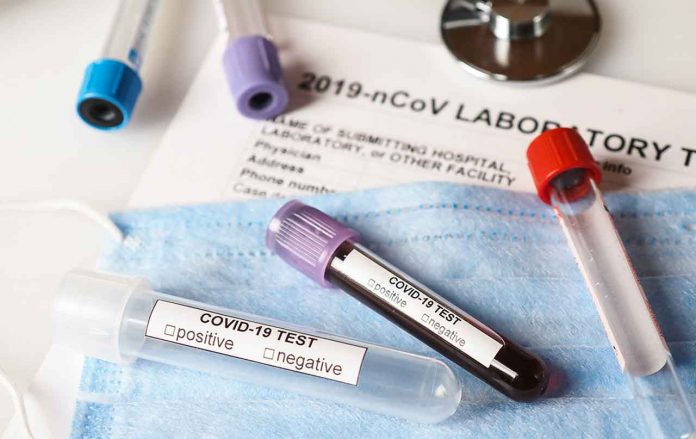The first symptoms of COVID-19 emerged on Christmas Eve.
I caught the virus while travelling in the United States, probably at a hockey game. I don’t know if it was the Omicron variant, but all signs point to it.
I tested negative twice before entering Canada. The morning after I arrived home, there the sickness was. I finally tested positive on December 26.
Frankly, I don’t know how anyone doesn’t catch coronavirus in the U.S. Mask mandates were barely enforced where I went. Watching tourists from Texas and Florida tell security guards off after being told to put masks on was a true highlight of this pandemic.
The next three days were a mixture of delirious fever, coughing, and more phlegm than I knew a body could produce. Cough medicine became my only friend. I hardly left bed.
My main thought during those days was how lucky I was that I had a place to isolate and not infect others. My daughter stayed with her mother. The rest of my family dropped off soup and medicine and steered clear.
My case of COVID-19 made the sickness very real for people around me, though. All remaining holiday visiting was cancelled. Zoom dinners and visits were scheduled. Gifts were dropped off instead of opened in person.
I realize coronavirus is to blame, but it’s hard not to feel responsible for ruining the holidays. I didn’t have to travel. I just wanted to see friends I hadn’t seen in two years. Later, I had to phone them and say: “Great visit, sorry I might have infected you.”
I am triple-vaxxed, so my bout with COVID-19 was really just a bad flu. I had breathing problems and couldn’t sleep but luckily didn’t have to go to the hospital.
Still, I couldn’t do anything for a week. Walking or moving around much wasn’t an option. I carried Kleenex and a garbage bag everywhere. I slept 12 hours a day and was constantly dizzy from coughing and choking up phlegm.
I could not think clearly, never mind work, for a lengthy amount of time. I did, however, read a lot of science.
I learned the Omicron variant spreads six times faster and multiplies 70 times faster inside human respiratory tissue than any other form of coronavirus (such as Delta).
Basically, the latest version of coronavirus is extremely hard to avoid after exposure, especially without medical masks and proper ventilation.
I learned the Omicron variant has affected young people more than any other version of coronavirus to date and that the more vaccine shots you get, the better protected you are (up to 90 per cent, depending on the study).
I also learned that, while still early in the research phase, scientists suggest the Omicron variant has less severe symptoms.
I also read all of the “other science” and nope, it’s not convincing.
By the time my symptoms left and I emerged from isolation on January 3, Manitoba had recorded more than 5,400 cases on the first weekend of the new year, including a record 1,721 cases on Monday. Seventy per cent (1,204) of those are in Winnipeg and 15,318 are considered active cases in the province. Of that, 228 people are in hospital, or 1.5 per cent.
Thankfully, I am no longer one of those people.
But, I have learned a simple fact: COVID-19 is real and, unless you hit the jackpot and are asymptomatic, it knocks you off your feet. In some rare but real cases, your life is in danger.
Now, though, I face the reality of my daughter going back to school next week. While provinces like Ontario have pushed back the return to classes for weeks, Manitoba is slow to make a decision.
My daughter — like virtually every student in Manitoba — is not as protected as me. Still, she’s as protected as is legally allowed: double-vaccinated.
I’m not just worried about her being in class or the hallway. She’s in choir, plays the flute, and is in a half-dozen after-school groups.
I went to one large public gathering and caught the coronavirus: a hockey game. She’s literally in five or six of those situations a day.
I’m hardly alone when it comes to being anxious. It’s clear that when someone contracts COVID-19 it takes up to three days to show symptoms and even days more to test positive.
All it takes is one student, one teacher, or one principal to infect dozens — maybe hundreds — of others, most of whom won’t even know it.
When students get infected (note I didn’t say “if”), they are out for up to two weeks.
The Manitoba Teachers’ Society has asked the province to move schools to remote learning in January.
Every teacher I spoke to has endorsed this idea, but said they need to know sooner rather than later to change their lesson plans and get ready for Monday.
So, what is Manitoba waiting for?
 Niigaan Sinclair
Niigaan Sinclair
Originally appeared in the Winnipeg Free Press in January 2022. Republished with the permission of the author.
The views, opinions, and positions expressed by all columnists and contributors are the author’s alone. They do not inherently or expressly reflect the views, opinions and/or positions of NetNewsLedger.

